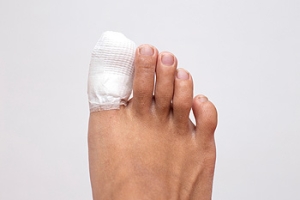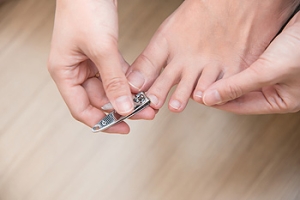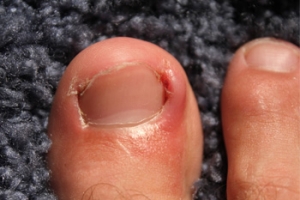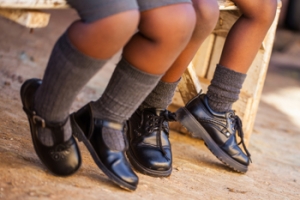(410) 764-7044
6506 Reisterstown Road, Baltimore
1205 York Road, Lutherville
6305 Belair Road, Baltimore
7809 Wise Avenue, Dundalk

What are the Symptoms of a Broken Toe?
 There are several ways to incur a broken toe. Repetitive motions can cause a hairline fracture in the toe, in addition to dropping a heavy object on it. Some people may experience stubbing a toe, which is the result of hitting it against a hard surface. This may produce severe discomfort and pain, and a broken toe may be an unfortunate result. There are noticeable symptoms associated with a broken toe, including swelling, bruising and difficulty in walking. The toe may appear deformed, and this may depend upon the severity of the fracture. It’s important to have a proper diagnose performed, and this is often accomplished by having an X-Ray taken. Treatment of a broken toe may include taping it to the toe next to it, which is often referred to as buddy taping. It’s important to speak with a podiatrist as quickly as possible to learn about additional treatment options concerning a broken toe.
There are several ways to incur a broken toe. Repetitive motions can cause a hairline fracture in the toe, in addition to dropping a heavy object on it. Some people may experience stubbing a toe, which is the result of hitting it against a hard surface. This may produce severe discomfort and pain, and a broken toe may be an unfortunate result. There are noticeable symptoms associated with a broken toe, including swelling, bruising and difficulty in walking. The toe may appear deformed, and this may depend upon the severity of the fracture. It’s important to have a proper diagnose performed, and this is often accomplished by having an X-Ray taken. Treatment of a broken toe may include taping it to the toe next to it, which is often referred to as buddy taping. It’s important to speak with a podiatrist as quickly as possible to learn about additional treatment options concerning a broken toe.
A broken toe can be very painful and lead to complications if not properly fixed. If you have any concerns about your feet, contact one of our podiatrists from Plaza Podiatry. Our doctors will treat your foot and ankle needs.
What to Know About a Broken Toe
Although most people try to avoid foot trauma such as banging, stubbing, or dropping heavy objects on their feet, the unfortunate fact is that it is a common occurrence. Given the fact that toes are positioned in front of the feet, they typically sustain the brunt of such trauma. When trauma occurs to a toe, the result can be a painful break (fracture).
Symptoms of a Broken Toe
- Throbbing pain
- Swelling
- Bruising on the skin and toenail
- The inability to move the toe
- Toe appears crooked or disfigured
- Tingling or numbness in the toe
Generally, it is best to stay off of the injured toe with the affected foot elevated.
Severe toe fractures may be treated with a splint, cast, and in some cases, minor surgery. Due to its position and the pressure it endures with daily activity, future complications can occur if the big toe is not properly treated.
If you have any questions please feel free to contact our offices located in Baltimore, Lutherville, and Dundalk, MD . We offer the newest diagnostic and treatment technologies for all your foot and ankle needs.
What to Know About a Broken Toe
Trauma to the foot, especially the toes, can occur in many ways. Banging them, stubbing them, or dropping something on them are a few different ways this trauma can occur. Given the fact that toes are positioned in front of the feet, they typically sustain the brunt of such trauma. When trauma occurs to a toe, the result can be a painful break or fracture. Another type of trauma that can break a toe is repeated activity that places stress on the toe for prolonged periods of time.
Broken toes can be categorized as either minor or severe fractures. Symptoms of minor toe fractures include throbbing pain, swelling, bruising on the skin and toenail, and the inability to move the toe with ease. Severe toe fractures require medical attention and are indicated when the broken toe appears crooked or disfigured, when there is tingling or numbness in the toe, or when there is an open, bleeding wound present on the toe.
Generally, a minor toe break will heal without long-term complications. However, it is important to discontinue activities that put pressure on the toe. It is best to stay off of the injured toe and immediately get a splint or cast to prevent any more additional movement of the toe bones. You can also immobilize your toe by placing a small cotton ball between the injured toe and the toe beside it. Then, tape the two toes together with medical tape. Swelling can be alleviated by placing an ice pack on the broken toe directly as well as elevating your feet above your head.
Severe toe fractures may be treated with a splint, cast, and in some cases, minor surgery, especially when the big toe has been broken. Due to its position and the pressure the big toe endures with daily activity, future complications can occur if it is not properly treated. Pain associated with minor toe fractures can be managed with over-the-counter pain medications. Prescription pain killers may be necessary for severe toe fractures.
The healing time for a broken toe is approximately four to six weeks. In severe cases where the toe becomes infected or requires surgery, healing time can take up to eight weeks or more. While complications associated with a broken toe are immediately apparent, it is important to note that there are rare cases when additional complications, such as osteoarthritis, can develop over time. You should immediately speak with your podiatrist if you think you have broken your toe due to trauma. They will be able to diagnose the injury and recommend the appropriate treatment options.
How to Properly Take Care of Your Feet
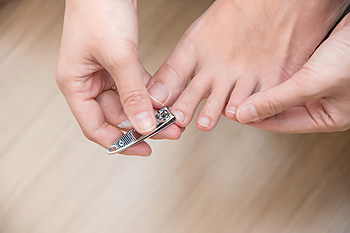 Most people like their feet to look and feel good, and this may be accomplished with a few minutes spent each day on proper foot hygiene. Many of us take our feet for granted as they carry us through the day. We may wear shoes that are uncomfortable or wear tight pantyhose and socks. There are several ways to pamper your feet and they will not only feel better, but may also look good. Some of these may include washing and drying the feet especially between the toes, which may prevent conditions such as athlete’s foot and foot fungus from developing. Additionally, using a moisturizer daily on your feet may keep the feet smooth during harsh winter months when the skin can become dry. The feet may feel good by wearing comfortable shoes and it may be beneficial to ensure the socks that are worn are not too tight. If you choose to partake in having pedicures performed, it’s advised to make sure the salon is sterile and clean. Please consult with a podiatrist for additional methods of how to properly take care of your feet.
Most people like their feet to look and feel good, and this may be accomplished with a few minutes spent each day on proper foot hygiene. Many of us take our feet for granted as they carry us through the day. We may wear shoes that are uncomfortable or wear tight pantyhose and socks. There are several ways to pamper your feet and they will not only feel better, but may also look good. Some of these may include washing and drying the feet especially between the toes, which may prevent conditions such as athlete’s foot and foot fungus from developing. Additionally, using a moisturizer daily on your feet may keep the feet smooth during harsh winter months when the skin can become dry. The feet may feel good by wearing comfortable shoes and it may be beneficial to ensure the socks that are worn are not too tight. If you choose to partake in having pedicures performed, it’s advised to make sure the salon is sterile and clean. Please consult with a podiatrist for additional methods of how to properly take care of your feet.
Everyday foot care is very important to prevent infection and other foot ailments. If you need your feet checked, contact one of our podiatrists from Plaza Podiatry. Our doctors can provide the care you need to keep you pain-free and on your feet.
Everyday Foot Care
Often, people take care of their bodies, face and hair more so than they do for their feet. But the feet are a very important aspect of our bodies, and one that we should pay more attention to. Without our feet, we would not be able to perform most daily tasks.
It is best to check your feet regularly to make sure there are no new bruises or cuts that you may not have noticed before. For dry feet, moisturizer can easily be a remedy and can be applied as often as necessary to the affected areas. Wearing shoes that fit well can also help you maintain good foot health, as well as making it easier to walk and do daily activities without the stress or pain of ill-fitting shoes, high heels, or even flip flops. Wearing clean socks with closed shoes is important to ensure that sweat and bacteria do not accumulate within the shoe. Clean socks help to prevent Athlete’s foot, fungi problems, bad odors, and can absorb sweat.
If you have any questions please feel free to contact our offices located in Baltimore, Lutherville, and Dundalk, MD . We offer the newest diagnostic and treatment technologies for all your foot and ankle needs.
Every Day Foot Care
Our feet are important in our everyday lives. The problem is that we tend to neglect them. When this becomes a habit, it can cause significant trouble. Ignoring foot problems can mean pain, limited mobility, and expensive doctor's visits. On the other hand, if feet are cared for and looked after regularly, they will perform without pain or complication.
Routine hygiene is the most basic way to care for the feet. Wash and dry them thoroughly daily. Remember to get between the toes and keep the toenails trimmed and short. If the feet feel dry or there are signs of dryness or cracking, use a moisturizer designed for the feet.
When using moisturizer on the feet, try to avoid applying between the toes. If cream or lotion sits too long, they can cause fungal and bacterial growth. When moisturizer is used between the toes, it can also cause the skin to soften too much.
Shoes are also an important aspect of foot care. When one is picking out shoes, make sure they are the correct size. Shoes need to be snug, but not too tight. On the other hand, if shoes are too loose they can cause foot problems as well. It is highly recommended that shopping for new shoes be done later in the day. The reason for this is that the feet will have settled and swelled to their full size by then. To keep your feet at their most healthy, avoid wearing high heels or flip flops too often. Instead, choose shoes that are good for your feet. Good shoes pad the soles of your feet and support the arches and ankles.
Socks should also be worn daily with closed-toe shoes. They may feel hot during the summer months, but they absorb sweat and moisture off the feet. Without socks, the build-up of sweat in a closed-toe shoe can cause fungal problems and athlete's foot.
The best thing to remember in every day foot care is that shoes do make a difference. If you spend a lot of time on your feet, make sure that your shoes show no signs of wear. Shoes should offer ample support for the arches and the overall foot. Additionally, try to make foot cleaning and maintenance a daily habit. If you keep these things in mind, your feet will stay healthy and safe.
The Causes of An Ingrown Toenail
 An ingrown toenail is a painful and uncomfortable foot condition that is a result of the toenail growing into the skin. If left untreated it may produce serious complications, and this may be especially true of diabetic patients. There may be several causes of this condition occurring, including trimming the toenails improperly, inherited genetic traits, and wearing shoes and socks that do not fit correctly. For some people, if they have incurred an injury such as stubbing or jamming their toe, they may observe that an ingrown toenail may begin to develop. There are noticeable symptoms that typically occur with this ailment, including the skin surrounding the toe appearing red, pain and discomfort that is experienced when pressure is applied to the toe, in addition to pus or blood oozing from the toe. If you feel you have developed an ingrown toenail, it’s advised to consult with a podiatrist, who can perform any treatment options that is recommended for you.
An ingrown toenail is a painful and uncomfortable foot condition that is a result of the toenail growing into the skin. If left untreated it may produce serious complications, and this may be especially true of diabetic patients. There may be several causes of this condition occurring, including trimming the toenails improperly, inherited genetic traits, and wearing shoes and socks that do not fit correctly. For some people, if they have incurred an injury such as stubbing or jamming their toe, they may observe that an ingrown toenail may begin to develop. There are noticeable symptoms that typically occur with this ailment, including the skin surrounding the toe appearing red, pain and discomfort that is experienced when pressure is applied to the toe, in addition to pus or blood oozing from the toe. If you feel you have developed an ingrown toenail, it’s advised to consult with a podiatrist, who can perform any treatment options that is recommended for you.
Ingrown toenails may initially present themselves as a minor discomfort, but they may progress into an infection in the skin without proper treatment. For more information about ingrown toenails, contact one of our podiatrists of Plaza Podiatry. Our doctors can provide the care you need to keep you pain-free and on your feet.
Ingrown Toenails
Ingrown toenails are caused when the corner or side of a toenail grows into the soft flesh surrounding it. They often result in redness, swelling, pain, and in some cases, infection. This condition typically affects the big toe and may recur if it is not treated properly.
Causes
- Improper toenail trimming
- Genetics
- Improper shoe fitting
- Injury from pedicures or nail picking
- Abnormal gait
- Poor hygiene
You are more likely to develop an ingrown toenail if you are obese, have diabetes, arthritis, or have any fungal infection in your nails. Additionally, people who have foot or toe deformities are at a higher risk of developing an ingrown toenail.
Symptoms
Some symptoms of ingrown toenails are redness, swelling, and pain. In rare cases, there may be a yellowish drainage coming from the nail.
Treatment
Ignoring an ingrown toenail can have serious complications. Infections of the nail border can progress to a deeper soft-tissue infection, which can then turn into a bone infection. You should always speak with your podiatrist if you suspect you have an ingrown toenail, especially if you have diabetes or poor circulation.
If you have any questions, please feel free to contact our offices located in Baltimore, Lutherville, and Dundalk, MD . We offer the newest diagnostic and treatment technologies for all your foot care needs.
Ingrown Toenails
Ingrown toenails (onychocryptosis) are a common foot ailment and it is very unpleasant to experience. The condition is caused by an increase in pressure from the ingrowth of the nail edge into the skin of the toe. Ingrown toenails commonly cause pain in those who experience them. In some cases, the skin surrounding the ingrown toenail may break which may lead bacteria to enter through and cause an infection. Common symptoms of this ailment include pain, redness, swelling, and warmth around the toe.
An imbalance between the size of the nail and the enlargement of the nail skin edge causes ingrown toenails. This condition is often caused by improperly trimming the toenails. If you are trying you cut your nails, you should always try to trim straight across instead of in a rounded shape. Ingrown toenails can also be an inherited condition and they may also be caused by improper shoe fitting.
Another common cause of the condition is wearing shoes that are either too small or too large. Other causes include poor foot hygiene, obesity, diabetes, arthritis, edema, and fungal infections. There are many risk factors that may make a person more likely to develop an ingrown toenail. Athletes who play “stop and start” sports such as tennis, soccer, and basketball are most likely to have ingrown toenails.
People who have diabetes, a compromised immune system, or poor circulation should immediately seek care from a podiatrist if they have an ingrown toenail. It is also recommended to seek professional assistance if at-home remedies are not successful within a week or if there is persistent pain.
Children Who Are Prone to Develop Sever’s Disease
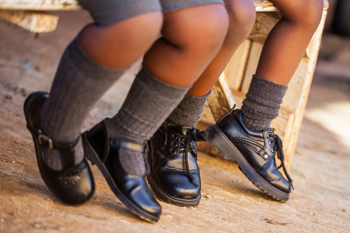 If your physically active child complains of heel pain, it may be a result of a condition referred as Sever’s disease. It is generally caused by excessive strain put on the growth plate of the heel, and typically affects children who are young adolescents. There are several symptoms that may be associated with Sever’s disease, including swollen heels, difficulty while walking, and tenderness in the foot and heel. The child may experience general pain and discomfort and it’s suggested to cease the activity that caused this condition while the healing takes places. Despite the fact that this ailment may be prevalent in physically active children, research has shown there may be additional factors in the development of Sever’s disease. These may include wearing shoes that do not fit correctly, obesity, or having flat or high arches. If you feel your child may have this affliction, please schedule a consultation with a podiatrist who will determine the best course of treatment as quickly as possible.
If your physically active child complains of heel pain, it may be a result of a condition referred as Sever’s disease. It is generally caused by excessive strain put on the growth plate of the heel, and typically affects children who are young adolescents. There are several symptoms that may be associated with Sever’s disease, including swollen heels, difficulty while walking, and tenderness in the foot and heel. The child may experience general pain and discomfort and it’s suggested to cease the activity that caused this condition while the healing takes places. Despite the fact that this ailment may be prevalent in physically active children, research has shown there may be additional factors in the development of Sever’s disease. These may include wearing shoes that do not fit correctly, obesity, or having flat or high arches. If you feel your child may have this affliction, please schedule a consultation with a podiatrist who will determine the best course of treatment as quickly as possible.
Sever's disease often occurs in children and teens. If your child is experiencing foot or ankle pain, see one of our podiatrists from Plaza Podiatry. Our doctors can treat your child’s foot and ankle needs.
Sever’s Disease
Sever’s disease is also known as calcaneal apophysitis, which is a medical condition that causes heel pain I none or both feet. The disease is known to affect children between the ages of 8 and 14.
Sever’s disease occurs when part of the child’s heel known as the growth plate (calcaneal epiphysis) is attached to the Achilles tendon. This area can suffer injury when the muscles and tendons of the growing foot do not keep pace with bone growth. Therefore, the constant pain which one experiences at the back of the heel will make the child unable to put any weight on the heel. The child is then forced to walk on their toes.
Symptoms
Acute pain – Pain associated with Sever’s disease is usually felt in the heel when the child engages in physical activity such as walking, jumping and or running.
Highly active – Children who are very active are among the most susceptible in experiencing Sever’s disease, because of the stress and tension placed on their feet.
If you have any questions, please feel free to contact our offices located in Baltimore, Lutherville, and Dundalk, MD . We offer the newest diagnostic and treatment technologies for all your foot and ankle injuries.
Sever's Disease
Sever's disease, also known as calcaneal apophysitis, is a medical condition that causes heel pain in children’s feet while they’re growing. Sever's disease occurs most commonly in boys and girls between the ages of 8 and 14.
Sever's disease occurs when the child’s growth plate, or the calcaneal epiphysis, an area attached to the Achilles tendon, is injured or when the muscles and tendons of the growing foot do not keep pace with bone growth. The result is constant pain experienced at the back of the heel and the inability to put any weight on the heel. This forces the child to bear weight on their toes while walking. When a toe gait develops, the child must change the way they walk to avoid placing weight on the painful heel. If this is not properly addressed, this can lead to further developmental problems.
The most common symptom of Sever's disease is acute pain felt in the heel when a child engages in physical activity such as walking, jumping or running. Children who are active athletes are among the group most susceptible to experiencing Sever's disease. This is due to the extreme stress and tension placed on their growing feet. The rolling movement of the foot during walking or running and obesity are both additional conditions linked to causing Sever's disease.
The first step in treating Sever's disease is to rest the foot and leg and avoid physical activity. Over the counter pain-relieving and anti-inflammatory medications can be helpful for reducing the amount of heel pain. A child with Sever's disease should also wear shoes that properly support the heel and the arch of the foot. Consider purchasing orthotic shoe inserts which can help support the heel and foot while it is healing. Most patients with Sever's disease symptoms report an eventual elimination of heel pain after wearing orthotic insoles that support the affected heel.
Sever's disease may affect either one heel or both. It is important for a child experiencing heel pain to be examined by a foot doctor who can apply the squeeze test. The squeeze test compresses both sides of the heel in order to determine if there is intense pain. Discourage any child diagnosed with Sever's disease from going barefoot as this can intensify the problem. Apply ice packs to the affected painful heel two or three times a day for pain relief.
Exercises that help stretch the calf muscles and hamstrings are effective at treating Sever's disease. An exercise known as foot curling has also proven to be very effective at treating Sever's disease. When foot curling, the foot is pointed away from the body, then curled toward the body to help stretch the muscles. The curling exercise should be done in sets of 10 or 20 repetitions and repeated several times throughout the day.
Treatment methods can continue for at least 2 weeks and as long as 2 months before the heel pain completely disappears. A child can continue doing daily stretching exercises for the legs and feet to prevent Sever’s disease from returning.
What May Be Causing Your Cracked Heels
 According to a survey, “20 percent of adults in the United States experience cracked skin on their feet.” Cracked heels are the result of an insufficient amount of moisture on the feet. In severe cases, cracks can eventually become sore and start to bleed. There are many reasons why a person’s feet may begin to dry out. Although more obvious causes for dry skin are cold weather or dehydration, many may not know that taking hot baths and hot showers can cause your skin to dry out. If your cracked heels are caused by an underlying medical condition, it is important that you do not treat them on your own. You may need the help of a podiatrist to treat your dry skin, regardless of your medical history. He or she will be able to recommend the best treatment option for you based on your consultation.
According to a survey, “20 percent of adults in the United States experience cracked skin on their feet.” Cracked heels are the result of an insufficient amount of moisture on the feet. In severe cases, cracks can eventually become sore and start to bleed. There are many reasons why a person’s feet may begin to dry out. Although more obvious causes for dry skin are cold weather or dehydration, many may not know that taking hot baths and hot showers can cause your skin to dry out. If your cracked heels are caused by an underlying medical condition, it is important that you do not treat them on your own. You may need the help of a podiatrist to treat your dry skin, regardless of your medical history. He or she will be able to recommend the best treatment option for you based on your consultation.
Cracked heels are unsightly and can cause further damage to your shoes and feet. If you have any concerns, contact one of our podiatrists from Plaza Podiatry. Our doctors can provide the care you need to keep you pain-free and on your feet.
Cracked Heels
Cracked heels appear unappealing and can make it harder for you walk around in sandals. Aside from looking unpleasant, cracked heels can also tear stockings, socks, and wear out your shoes. There are several methods to help restore a cracked heel and prevent further damage.
How Do You Get Them?
Dry skin is the number one culprit in creating cracked heels. Many athletes, walkers, joggers, and even swimmers suffer from cracked heels. Age and skin oil production play a role to getting cracked heels as well.
Promote Healing
Over the counter medicines can help, especially for those that need instant relief or who suffer from chronic dry feet.
Wear Socks – Wearing socks with medicated creams helps lock in moisture.
Moisturizers – Applying both day and night will help alleviate dryness which causes cracking.
Pumice Stones – These exfoliate and remove dead skin, which allows for smoother moisturizer application and better absorption into the skin.
Change in Diet
Eating healthy with a well-balanced diet will give the skin a fresh and radiant look. Your body responds to the kinds of food you ingest. Omega-3 fatty acids and zinc supplements can also revitalize skin tissue.
Most importantly, seek professional help if unsure how to proceed in treating cracked heels. A podiatrist will help you with any questions or information needed.
If you have any questions, please feel free to contact our offices located in Baltimore, Lutherville, and Dundalk, MD . We offer the newest diagnostic and treatment technologies for all your foot care needs.
Solutions for Cracked Heels
Cracked heels can make life very frustrating and embarrassing when displaying the bare feet. Aside from being unpleasing to the eye, they can also tear stockings and socks and wear out shoes at a faster rate. When severe, cracked heels may cause pain or infection.
Cracked heels are a problem for those who are athletic, those who may walk a lot, and those who have especially dry skin. Those who use medication that dry the skin, those who swim often, wearing certain types of shoes, and those who are diabetic may have trouble with cracked heels. Seniors whose skin produces less oil may also have trouble with cracked feet. There is no one way to develop cracked feet, and there is no cure.
Today, the market consists of numerous products that have a variety of ingredients to promote healing. Some of these are over-the-counter. Others are prescribed by a doctor, especially for those who have chronic dry feet and heels.
Some doctors recommend wearing socks at night for those with rough skin. This helps further healing, and helps creams stay on longer and better absorb into the skin.
One way to alleviate dryness that causes cracked heels is by using moisturizers both day and night. Another way is to make sure the skin is clean and dry at all times. Using a pumice stone to buff away dead skin before putting on moisturizer can also help. Cracked heels will not respond to the cream unless the outer layer of skin is first removed through exfoliation. After exfoliation, lotion or ointment will be absorbed by the skin more easily.
Foods that produce healing and balance can also help the skin from within. Everything that is put into the body can either help it or hurt it. Taking supplements of omega-3 fatty acids and zinc can also be very beneficial.
Nevertheless, not all products are guaranteed to help treat cracked feet. Seeing a professional is best if other treatments options were unsuccessful. A podiatrist should be able to give the best advice to help with this problem.

